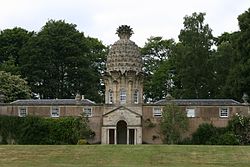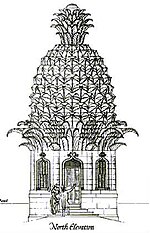The Pineapple: Difference between revisions
No edit summary |
|||
| (One intermediate revision by the same user not shown) | |||
| Line 7: | Line 7: | ||
|type=garden | |type=garden | ||
|os grid ref=NS888884 | |os grid ref=NS888884 | ||
|latitude=56.07627 | |||
|longitude=-3.79295 | |||
|website={{NT link}} | |website={{NT link}} | ||
}} | }} | ||
| Line 41: | Line 43: | ||
==Ownership and restoration history== | ==Ownership and restoration history== | ||
After remaining in the family for centuries, the Dunmore Estate was broken up in 1970 and sold in lots. One lot, called the "Pineapple Lot", included the folly and the large walled garden, along with some woodlands and a small lake. This lot was purchased by the Countess of Perth, and in 1974 was given to the [[National Trust for Scotland]]. The "Pineapple Lot" was then leased to the Landmark Trust, who restored the building and used it to provide holiday accommodation.<ref>Sherban Cantacuzino and Susan Brandt, ''Saving Old Buildings''. London: Architectural Press, 1989, p. 184.</ref> The | After remaining in the family for centuries, the Dunmore Estate was broken up in 1970 and sold in lots. One lot, called the "Pineapple Lot", included the folly and the large walled garden, along with some woodlands and a small lake. This lot was purchased by the Countess of Perth, and in 1974 was given to the [[National Trust for Scotland]]. The "Pineapple Lot" was then leased to the Landmark Trust, who restored the building and used it to provide holiday accommodation.<ref>Sherban Cantacuzino and Susan Brandt, ''Saving Old Buildings''. London: Architectural Press, 1989, p. 184.</ref> The 16 acres of gardens, including woodland, pond and crab-apple orchard, are open to the public year-round. | ||
Today, the gardeners' quarters and the pineapple summerhouse may be rented as a holiday home. The bothy on one side of the Pineapple houses two bedrooms and a bathroom, and the bothy on the other side contains a kitchen and a spacious living room.<ref>Bettina Kowalewski, ''Bed in a Tree''. New York: DK Publishing, 2009.</ref> The rooms have sash windows with a southern exposure overlooking the main (lower) lawn of the estate. Due to their southern exposure, the windows ensure that the rooms are sunlit throughout the day. | Today, the gardeners' quarters and the pineapple summerhouse may be rented as a holiday home. The bothy on one side of the Pineapple houses two bedrooms and a bathroom, and the bothy on the other side contains a kitchen and a spacious living room.<ref>Bettina Kowalewski, ''Bed in a Tree''. New York: DK Publishing, 2009.</ref> The rooms have sash windows with a southern exposure overlooking the main (lower) lawn of the estate. Due to their southern exposure, the windows ensure that the rooms are sunlit throughout the day. | ||
| Line 52: | Line 54: | ||
*[http://gillonj.tripod.com/ascottishpineapple/ A Scottish Pineapple] | *[http://gillonj.tripod.com/ascottishpineapple/ A Scottish Pineapple] | ||
*[http://bookings.landmarktrust.org.uk/BuildingDetails/Overview/230/The_Pineapple#/ Landmark Trust - The Pineapple] | *[http://bookings.landmarktrust.org.uk/BuildingDetails/Overview/230/The_Pineapple#/ Landmark Trust - The Pineapple] | ||
==References== | ==References== | ||
Latest revision as of 12:22, 30 June 2017
| The Pineapple | |
|
| |
|---|---|

| |
| Grid reference: | NS888884 |
| Location: | 56°4’35"N, 3°47’35"W |
| Information | |
| Website: | The Pineapple |
The Pineapple is reckoned one of the architectural wonders of Britain. It was built in 1761 by the Earl of Dunmore within Dunmore Park, as a garden retreat. This imaginative folly certainly is one of the most unusual buildings in Britain, built in the shape of a giant pineapple.
The Pineapple is found between Dunmore and Airth in Stirlingshire, about half a mile from each.
It is the centrepiece of Dunmore Park, which ornate gardens and woodland are owned and maintained by the National Trust for Scotland.
The gardens today may be enjoyed by the public and are rich in wildlife.
The walled garden at Dunmore Park
Dunmore Park is the ancestral home of the Earls of Dunmore. It includes a large country mansion, Dunmore House (built in the “Tudor Gothic” style in 1820-22, but now derelict)[1] The grounds contain, among other things, two large walled gardens, necessary for cultivating fruit, vegetables, and ornamental plants, which could not otherwise survive the fierce, frosty winds of the northern shires.
The larger of the two gardens covers about six acres, located on a gentle south-facing slope. Along the north edge of the garden, the slope had probably originally been more steep. To allow both the upper and lower parts of the garden to be flat and level at different heights, it was necessary to bank up the earth on the higher northern side (away from the main house), behind a retaining wall about 16 feet high, and a solid 3 feet, 3 inches thick, which runs the entire length of the north side of the garden.[2]
The Pineapple
A building containing a hothouse was built into this wall in 1761 by John Murray, 4th Earl of Dunmore. The hothouse, which was located in the ground floor of the building, was used, among other things, for growing pineapples. The south-facing ground floor, which is now covered in stucco and largely overgrown with vines, was originally covered with glass windowpanes.[3] Additional heat was provided by a furnace-driven heating system that circulated hot air through cavities in the wall construction of the adjoining hothouse buildings. The smoke from the furnace was expelled through four chimneys, cleverly disguised as Grecian urns. The upper floor, which is at ground level when approached from the raised northern lawn, contained two small cottage-like apartments, or "bothies", for the gardeners.[4]
Murray left Britain after the initial structure had been built, and the King appointed him Governor of Virginia in America. The upper-floor pavilion or summerhouse with its pineapple-shaped cupola and the Palladian lower-floor portico on the south side were added after Murray’s return from Virginia.

The building is a mixture of architectural styles. The south (ground floor) entrance takes the form of a characteristically Palladian Serliana archway, incorporating Tuscan columns. Visitors who step through this archway and into the vestibule below the pineapple face an elaborately framed doorway, flanked, on either side, by pairs of painted wooden Ionic columns, carved with great care, which display perfect fluting and even architecturally correct entasis.[1] The keystone of the Serliana arch is inscribed with the date “1761.” This has caused some people to speculate that the pineapple was constructed in 1761,[5] although there is no clear evidence that the archway and the pineapple were built at the same time, or even designed by the same architect. Others suggest that the pineapple was constructed after Murray's return from America in 1776.[6]
Above the Serliana arch is inserted a “later and clumsier,”[7] panel bearing a relief carving of a heart charged with a cinquefoil knot and inscribed with the motto Fidelis in Adversis. The design and motto are taken from the Douglas-Hamilton coat of arms, and probably commemorate the marriage, in 1803, of George Murray, 5th Earl of Dunmore|George Murray, the 5th Earl of Dunmore, to Lady Susan Douglas-Hamilton, daughter of Archibald Hamilton, 9th Duke of Hamilton.
The intricately carved stone pineapple, which is situated between the two bothies, forms an elaborate cupola atop an octagonal pavilion, with sash windows topped with Gothic ogee arches on seven sides and a door, topped with an ogee transom, on the eighth. The door, on the north side, exits onto the upper level of the garden. Inside the pavilion, the stone walls are gently curved, so that the room is circular rather than octagonal. Even the door and the panes of glass in the seven windows are curved, so as to match the curve of the walls in the room.[8] The pavilion is just large enough to house a round table and some chairs.
The pineapple is around 46 feet high and is a stunning example of the stonemason's craft; a remarkably accurate depiction of a pineapple in vast scale but crafted to the needs of architecture. Each of the curving stone leaves is separately drained to prevent frost damage, and the "stiff serrated edges of the lowest and topmost leaves and the plum berry-like fruits are all cunningly graded so that water cannot accumulate anywhere, ensuring that frozen trapped water cannot damage the delicate stonework."[9]
Despite the unconventional design and the mix of architectural styles, the effect is harmonious because the pineapple and the portico are made of the same stone (ensuring a single colour from top to bottom) and are of a consistent width. Together, they draw the eye upwards in a single smooth motion. The height of the building, from the bottom of the lower floor to the top of the pineapple, is exactly half the width of the structure. Additionally, the width of the portico and pineapple matches the height of the south façade. Together, these elements, along with the four equally spaced urn-shaped chimneys, add to the sense of Classical order and harmony.
The identity of the designer of the folly is uncertain, but it is often attributed to Sir William Chambers who designed similar fanciful structures at Kew Gardens, and who showed a similarly meticulous attention to detail (including curved panes of glass and chimneys disguised as rooftop urns) in his design for the Casino at Marino, just outside Dublin
Ownership and restoration history
After remaining in the family for centuries, the Dunmore Estate was broken up in 1970 and sold in lots. One lot, called the "Pineapple Lot", included the folly and the large walled garden, along with some woodlands and a small lake. This lot was purchased by the Countess of Perth, and in 1974 was given to the National Trust for Scotland. The "Pineapple Lot" was then leased to the Landmark Trust, who restored the building and used it to provide holiday accommodation.[10] The 16 acres of gardens, including woodland, pond and crab-apple orchard, are open to the public year-round.
Today, the gardeners' quarters and the pineapple summerhouse may be rented as a holiday home. The bothy on one side of the Pineapple houses two bedrooms and a bathroom, and the bothy on the other side contains a kitchen and a spacious living room.[11] The rooms have sash windows with a southern exposure overlooking the main (lower) lawn of the estate. Due to their southern exposure, the windows ensure that the rooms are sunlit throughout the day.
Outside links
- The Pineapple – National Trust for Scotland
- Falkirk Online
- Gazeteer for Scotland
- A Scottish Pineapple
- Landmark Trust - The Pineapple
References
- ↑ Howard Colvin: A Biographical Dictionary of British Architects, 1600-1840, 3rd ed. [Yale University Press] 1995, s.v. "William Wilkins").
- ↑ The physical details of the wall are provided in: Royal Commission on the Ancient and Historical Monuments of Scotland. Vol. II, Stirlingshire: An Inventory of the Ancient Monuments. Edinburgh: Her Majesty's Stationery Office, 1963, p. 341.
- ↑ Caroline Holmes, Nic Barlow and Tim Knox, Follies of Europe: Architectural Extravaganzas. London: Garden Art Press, 2008, p. 119.
- ↑ Caroline Holmes, Nic Barlow and Tim Knox, Follies of Europe: Architectural Extravaganzas. London: Garden Art Press, 2008, p. 119.
- ↑ For example, see Tim Buxbaum, Scottish Garden Buildings: From Food to Folly. Edinburgh: Mainstream Publishers, 1989, p. 50; JB Stevenson, Exploring Scotland's Heritage: The Clyde Estuary and Central Region. Edinburgh: Her Majesty's Stationery Office, 1985, p. 59.
- ↑ Fran Beauman, "The King of Fruit" in Cabinet, Issue 23 (Fall 2006), p. 94.
- ↑ Barbara Jones, Follies & Grottoes London: Constable, 1974, p. 96.
- ↑ Bettina Kowalewski, Bed in a Tree. New York: DK Publishing, 2009, p. 100.
- ↑ Caroline Holmes, Nic Barlow and Tim Knox, Follies of Europe: Architectural Extravaganzas. London: Garden Art Press, 2008, p. 119.
- ↑ Sherban Cantacuzino and Susan Brandt, Saving Old Buildings. London: Architectural Press, 1989, p. 184.
- ↑ Bettina Kowalewski, Bed in a Tree. New York: DK Publishing, 2009.
